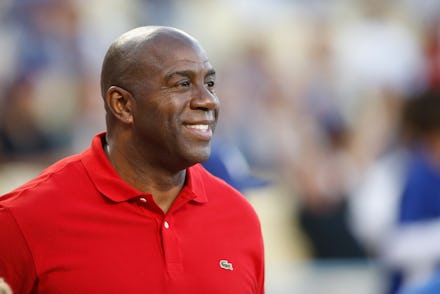Magic Johnson Just Hit a Milestone Many Thought Was Impossible 24 Years Ago

Basketball legend and business mogul Magic Johnson turns 56 on Friday.
That may seem like a fairly innocuous milestone. But back in 1991, when Johnson, then 32, shocked the world and announced that he was HIV-positive, living through middle age seemed all but impossible.
Instead, Johnson has thrived, providing a vivid example of what's possible when a person has access to the world's best HIV/AIDS treatment. The sad part is that he is the exception, not the rule, in black America.
"It completely changed the perception of HIV in the United States," Phil Wilson, president and CEO of the Black AIDS Institute, told Mic. "The predominant perception was that HIV was a white gay disease. Even though Arthur Ashe had died by then, along with a number of other high-profile black Americans, the attention in black communities was not consistent and strategic prior to Magic's disclosure."
Johnson himself thought an HIV diagnosis was a death sentence. "'Oh, man, I am going to die. I think it's over,'" he remembers telling the doctor who gave him the news, according to PBS. But his doctor had two important pieces of advice: "'Well, the first thing you have to do is take your meds,' and I said, 'OK, I can do that.' And the second thing he said was, 'You've got to be comfortable with your new status.'"
At the time of Johnson's announcement, AIDS had become the No. 1 cause of death for men between the ages of 25 and 44. By the end of that year, nearly 258,000 people had been diagnosed with AIDS in the United States, and over 157,000 people had died from the disease. Johnson's announcement came in the midst of what's widely known as the AIDS epidemic, when AIDS-related deaths topped 29,850 in 1991 in the United States and little was known in popular culture about how the disease was spread.
Plenty has changed in the intervening years. New drugs have dramatically increased life expectancies for people living with HIV. In the 1990s, doctors and social service agencies scrambled to figure out how to extend care to patients who were considered chronically, not terminally, ill. Today, more than 1.2 million people in the United States live with HIV.
New drugs like pre-exposure prophylaxis, as described by Tim Murphy at New York magazine last year, have reintroduced the concept of "sex without fear" for gay men. America's money for and focus on the disease have moved abroad to places like sub-Saharan Africa, where roughly 25 million people are living with the disease.
But the U.S., hasn't totally escaped the epidemic. One out of 8 people infected with HIV are unaware of their status, according to federal statistics. Young people between the ages of 13 and 24 make up 1 in 4 new infections, and many, also unaware of their status, are also going without treatment.
The crisis is especially acute in black America. "With respect to HIV, black America looks more like many developing countries than like the high-income north in which it is geographically located," researchers wrote in a 2008 report detailing how the crisis has crippled African-Americans. By most any measure, black Americans are the group most affected by HIV/AIDS in the U.S. They account for 44% of all new infections, despite making up only 13% of the U.S. population. The disease disproportionately affects black gay and bisexual men, who represent an estimated 72% of all infections for black men and 36% of infections of the nearly 30,000 new infections among all gay and bisexual men, according to the Centers for Disease Control and Prevention.
The agency also estimates that the rate of new HIV infections for black women was 20 times that of white women, and nearly five times that of Latinas. Atlanta, a largely African-American city, is ranked fifth along U.S. cities grappling with new HIV diagnoses. But half of those new diagnoses are of patients who already have AIDS, a much more advanced disease than HIV which generally takes about 10 years to develop, if left untreated.
What's helpful, according to advocates, is that now HIV infection is being viewed alongside a host of other contextual issues. "HIV does not stand alone," C. Virginia Fields, president and CEO of the National Black Leadership Commission on AIDS, told Mic. Fields notes that race, poverty, drug use and employment status are just some of the factors that play an important role in who's contracting and living with HIV/AIDS.
There's been progress. The Obama administration introduced the first-ever White House Office of National AIDS Policy, which in published the National HIV/AIDS Strategy, a five-year plan that runs its course at the end of 2015. Released in 2010, the strategy opens with an admission from President Barack Obama that the current crisis "demands a renewed commitment" but operates from the vision that new HIV infections in the U.S. will become increasingly rare, and when they do happen, those infected "will have unfettered access to high quality, life-extending care, free from stigma and discrimination." At the moment, the U.S. generally and black Americans in particular are far from that goal.
It's a message that Johnson himself has helped promote in the black community since his diagnosis. "I'm the blessing because people were talking about it, they ran out and got tested at that time," Johnson told CNN in 2013. "Then I'm the curse, because people now say, 'Oh well, HIV is nothing, because if I get it, I can be like Magic. He's doing good, and I can do the same thing he's doing or take the same medicine he's taking and I'll be okay.' But what they don't understand, in 22 years, millions of people have died."
Progress, according to advocates, can't be mistaken for a cure.
"People confuse things being better with the problem being solved," Wilson, of the Black AIDS Project, said. "They're not the same."
Correction: Aug. 15, 2015